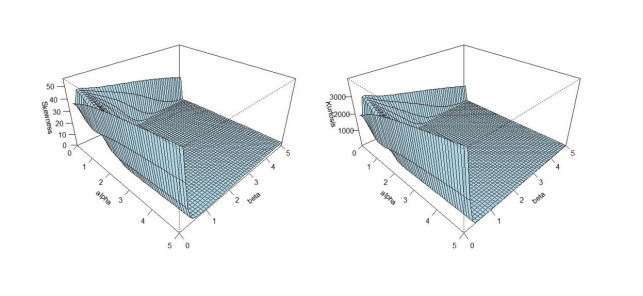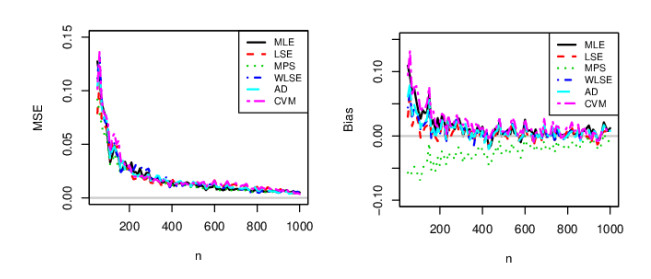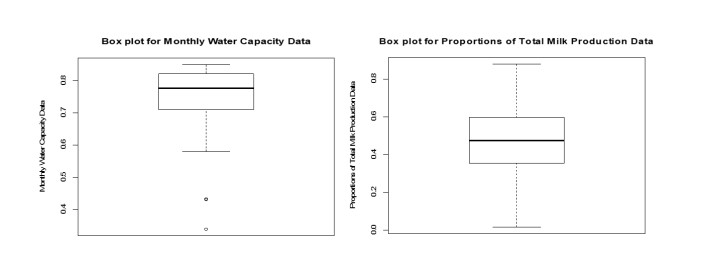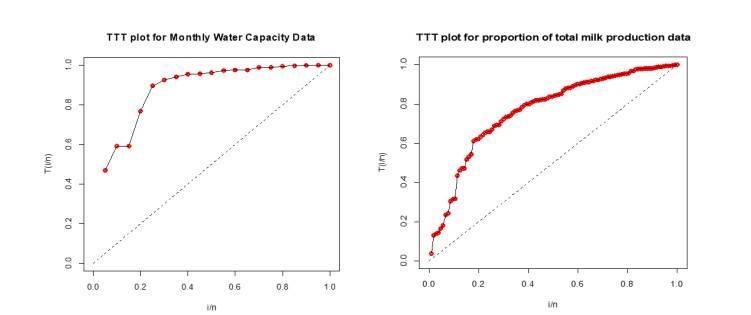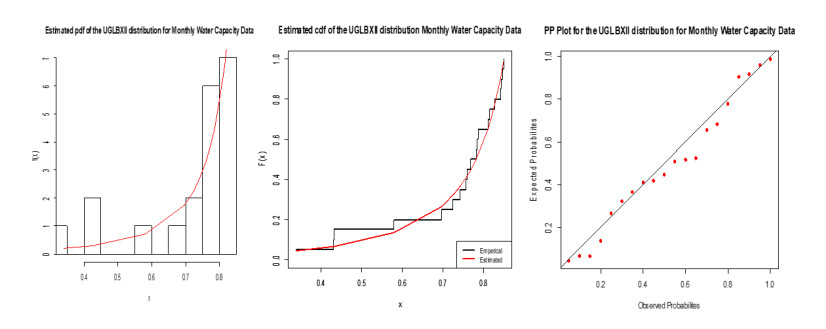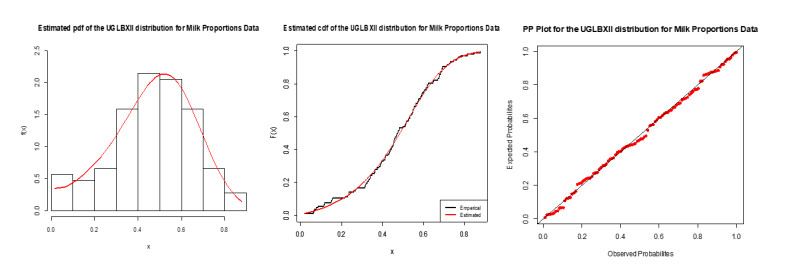1.
Introduction
Statistical distributions bounded on (0, 1) are useful tools to describe uncertainty phenomena. For modeling proportions, percentages, indices, rates and ratios measured on the unit interval, many new continuous unit distributions have been developed. In statistical literature, the most famous unit distribution is the beta distribution, since it is a convenient and useful model in many areas of statistics. However, its data modeling ability may be insufficient to explain the data. So, there are some alternative distributions to beta distribution in the literature such as the Johnson SB distribution [1], Topp-Leone distribution [2], the unit-Gamma distribution [3,4], the Kumaraswamy distribution [5], the Arcsine distribution [6], the unit-Logistic distribution [7], the Simplex distribution [8], the unit-Birnbaum-Saunders distribution [9], the unit-Weibull distribution [10], the unit-Gompertz distribution [11], the unit-Lindley distribution [12], the unit-improved second-degree Lindley distribution [13], the unit-inverse Gaussian distribution [14], the unit half normal distribution [15], the logit slash distribution [16], the arc-secant hyperbolic normal distribution [17] and the TURQ distribution [18]. Many of the above mentioned distributions have been obtained via transforming of the base distribution and they have given better results than beta distribution in terms of the data modeling.
We aim to propose a new unit distribution with many sub-models on (0, 1) interval in order to obtain flexible density function with various shapes and skewed forms in the unit interval. The UGLBXII distribution is important due to (i) it has simple and closed form expressions for the cumulative distribution function and quantile function; (ii) it can provide increasing, bathtub, N-shaped and bimodal hazard rate and (iii) it can provide better fits than other well-known distributions defined on the unit interval. Further, We focus on the following motivations: (i) to develop distributions with various density shaped model as well as high kurtosis; (ii) to have monotone and non-monotone failure rate function; (iii) to derive mathematical properties such as random number generator, sub-models, ordinary moments, generalized TL moments, conditional moments, reliability measures, uncertainty measures and characterizations; (iv) to present the bivariate and multivariate‐type distributions; (v) to estimate the precision of the different estimators via simulation studies; (vi) to illustrate the potentiality of the UGLBXII model; (vii) to employ as the preeminent substitute model to the other existing models and (viii) to deliver a better fit model than other models.
The content of the article is prepared as follows. In Section 2, we derive the UGLBXII distribution. We also study basic structure related properties like random number generator and sub-models. Section 3 presents certain mathematical properties such as ordinary moments, generalized TL moments, conditional moments, reliability and uncertainty measures. We also present the bivariate‐ and multivariate‐type distributions. Section 4 provides certain characterizations of the UGLBXII distribution via innovative techniques. In Section 5, we adopt six estimation methods to estimate its unknown parameters. We carry out simulation studies on the basis of the graphical results to see the performance of the above estimators. In Section 6, we consider two applications to illustrate the potentiality of the UGLBXII model. Concluding remarks are given in Section 7.
2.
The UGLBXII distribution
We derive the probability density function (pdf) of the UGLBXII distribution and discuss its basic structural properties.
2.1. Development of the UGLBXII distribution
In this sub-section, we derive the pdf of the UGLBXII distribution using the Pearson differential equation given by
For transformation x=e−t, Pearson differential equation is
Taking m=n=2β+1, a0=(2β−1)λ2β, a1=−λ2β, a2=a3...am−2=0, am−1=−(2αβ+1), am=−1, b0=0 b1=λ2β, b0=b2=b3...=bn−1=0,bn=1, we arrive at
Integrating (3), we obtain
Using condition 1∫0f(x)dx=1, the normalizing constant is k=2αβλ and the pdf of UGLBXII distribution is
The cdf corresponding to (4) is
2.2. Relationship between the exponential and gamma variable
Here, we derive the UGLBXII distribution from a relationship between the exponential and gamma random variables, i.e., W1∼exp(1) and W2∼gamma(α,1). W1and W2 independently distributed
Lemma (i). Let W1∼exp(1) and W2∼gamma(α,1) be independently distributed, then for W1=(−lnXλ)2βW2, we have X=exp[−λ(W1W2)12β] ~ UGLBXII (α,β,λ).
Proof. Let W1∼exp(1) i.e., f(w1)=e−w1,w1>0, and W2∼gamma(α,1), i.e., f(w2)=w2α−1e−w2Γ(α),w2>0. The joint density of W1,W2 is f(w1,w2)=w2α−1e−w2e−w1Γ(α),w1>0,w2>0. Let W1=(−lnXλ)2βW2, the joint density of X and W2 is
The marginal density of X is
After simplification, we have
which is the UGLBXII density.
2.3. Structural properties
If X~ UGLBXII (α,β,λ), the survival function, failure rate function, cumulative hazard function, reverse hazard function and elasticity are given, respectively, by
and
The quantile function of the UGLBXII distribution for 0<q<1 is x=exp[−λ(q−1α−1)12β].
The random number generator of the UGLBXII distribution for U ~Uniform (0, 1) is given by
2.4. Sub models of the UGLBXII distribution
i). For λ=1, the UGLBXII distribution reduces to the unit log Burr XII (ULBXII) distribution.
ii). For β=0.5, the UGLBXII distribution reduces to the unit log Lomax (ULL) distribution.
iii). For α→∞,λ=γα12β, the UGLBXII distribution becomes the unit log generalized Weibull (UGLW) distribution.
iv). For α→∞,λ=γα12β,β=0.5, the UGLBXII distribution becomes the unit log-exponential distribution.
v). For X−1, the UGLBXII distribution reduces to the generalized log Burr XII (GLBXII) distribution [19].
vi). For X−1 and λ=1, the UGLBXII distribution reduces to the log Burr XII (LBXII) distribution.
2.5. Plots of the UGLBXII density and failure rate functions
We plot the pdf and failure rate functions of the UGLBXII distribution to the selected parameters values. Figure 1 displays that the UGLBXII density can take various shapes such as decreasing, unimodal, U-shaped, decreasing-increasing-decreasing (inverse N-shaped) and the possible pdf's regions of the UGLBXII density with λ=1 . On the other hand, Figure 2 shows that failure rate function can be increasing, bathtub, N-shaped and bimodal. Therefore, the UGLBXII distribution is quite flexible and can be applied for numerous data sets.
3.
Mathematical properties
We present some properties such as ordinary moments, generalized TL moments, conditional moments, reliability and uncertainty measures. We also present the bivariate and multivariate‐type distributions.
3.1. Moments
The moments are significant tools for statistical analysis in pragmatic sciences. The rth ordinary moment of X is
Setting (−lnxλ)2β=w, we can write
The Mellin transformation M{f(x);s}=f∗(s)=E[Xs−1] is applied to get the moments of X as
The rth central moment (μr), coefficients of skewness (γ1) and kurtosis (γ2) of X are
The numerical values for the mean (μ′1), median (˜μ), standard deviation (σ), skewness (γ1) and kurtosis (γ2) of the UGLBXII distribution for selected values of α,β,λ are listed in Table 1. Figure 3 shows the skewness and kurtosis of the distribution for the selected parameters values with λ=1.
3.2. The generalized TL-moments
Elamir and Seheult [20] developed generalized TL-moments. The expression for rth generalized TL-moment is
where λ(m,n)r is a function of E(Xr+m−ℓ:r+m+n) and m and n are the probable trimming lowermost and uppermost values, respectively.
The pdf of ( r+m−ℓ )th order statistic Xr+m−ℓ:r+m+n for the UGLBXII distribution is
The kth moment about the origin of Xr+m−ℓ:r+m+n for the UGLBXII model is
Letting (−lnxλ)2β=w, we arrive at
Mean of Xr+m−ℓ:r+m+n for the UGLBXII distribution is
The rth generalized TL-moment is obtained as
The rth generalized TL-moment can be used to obtain the rth L-moment (0, 0), LL-moments (0, n), TL-moment (1, 1) and LH-moment (m, 0) for the UGLBXII distribution. The first two moments λ(m,n)1 and λ(m,n)2 are employed to compute the location and dispersion of the data, respectively. L−CV=λ(m,n)2λ(m,n)1 is coefficient of variation. τr=λ(m,n)rλ(m,n)2, r⩾3, τ3=λ(m,n)3λ(m,n)2 and τ4=λ(m,n)4λ(m,n)2 are measures for skewness and kurtosis, respectively.
3.2.1. The TL-moments (1, 1)
When only the extreme observations are trimmed from the array sample, then the rth generalized TL-moment befits rth TL-moment (m = n = 1). The rth TL-moment is obtained as follows
3.2.2. The L-moments [21]
When no value is trimmed from the array sample, then the rth generalized TL-moment becomes rth L-moment (m = n = 0). L-moments are used for estimation of the parameters. The rth L-moment for the UGLBXII distribution is
3.2.3. The LH-moments [22]
When lowermost m values are trimmed from the array sample, then the rth generalized TL-moment becomes rth LH-moment (m, 0). The rth LH-moments (m, 0) gives more weight to the upper part of data. The rth LH-moment for the UGLBXII distribution is
3.2.4. The LL-moments [23]
When the uppermost n values are trimmed from the array sample, then the rth generalized TL-moment becomes rth LH-moment (0, n). The rth LL-moments (0, n) gives more weight to the lowermost part of data. The rth LL-moment for the UGLBXII distribution is
3.3. Conditional moments
The rth conditional moment of X is E(Xk|X>z)=1S(z)[EX>z(Xk)]. The kth incomplete upper moment about the origin for X is
where S(z) is survival function and B(z;.,.) is the incomplete beta function. The kth conditional moment of X is
The rth reversed conditional moment of X is E(Xk|X⩽z)=1F(z)[EX⩽z(Xk)]. The kth incomplete lower moment about the origin for X is
where F(z) is cdf and B(z;.,.) is the incomplete beta function. The kth reversed conditional moment of X is
The mean deviation about the mean (δ1=E|X−μ|) and about the median (δ2=E|X−˜μ|) can be written as δ1=2μF(μ)−2μM′1(μ) and δ2=μ−2M′1(˜μ), respectively, where μ=E(X) and ˜μ=x0.5.The quantities M′1(μ) and M′1(˜μ) can be obtained from (6). For specific probability p, Lorenz and Bonferroni curves are computed as L(p)=M′1(q)μ′ and B(p)=L(p)|p, where q=Q(p).
3.4. Reliability in multicomponent stress-strength model
Consider a system with κ identical elements, out of which s elements are operative. Let Xi,i=1,2...κ represent strengths of κ elements with the cdf F while, the stress Y enforced on the elements has the cdf G. The strengths Xi and stress Y are independently and identically distributed (i.i.d.). The probability that system operates properly, is the reliability of the system, i.e.,
Then, we can write this probability (from [24]) as follows:
Let X~UGLBXII (α1,β,λ), Y~ UGLBXII (α2,β,λ) with unknown α1andα2, common β,λ where X and Y are independently distributed. The reliability in multicomponent stress-strength model for the UGLBXII distribution is
Setting ω=[1+(−lnyλ)2β]−α2, we obtain Rs,κ=κ∑ς=s(κς)1∫0(1−ωϑ)ςωϑ(κ−ς)dω, where ϑ=α1α2.
Letting u=ωϑ,
The probability in (7) is called the reliability in a multicomponent stress-strength model.
For s =κ = 1, the multicomponent stress-strength model reduces to the stress-strength model [25] as
3.5. Uncertainty measures
The measure of uncertainty of a random variable (rv) is called entropy. Rényi entropy generalizes Hartley, Min, Shannon and collision entropies. Entropies are useful to study daily temperature instabilities (climatic), abnormal diffusion, DNA structures, information content gestures, heart rate variability (HRV) and cardiac autonomic neuropathy (CAN). Here, we study Shannon entropy, Awad entropy, Rényi, Q, Havrda, Chavrat and Tsallis-entropies.
Claude Shannon [26] measured expected information in a message. Shannon entropy is given by
where ψ(α)=ddp[lnΓα] is the digamma function.
Awad and Alawneh [27] provided the extension of Shannon entropy as A(X)=−∞∫1f(x)lnf(x)δdx.
For X~UGLBXII (α,β,λ), the Awad entropy is given by
For X~UGLBXII (α,β,λ), Rényi entropy [28] is given by
Now taking
Considering 1∫0x−ν(−lnxλ)2βℓ+2βν−νdx and letting (−lnxb)=w, we arrive at
The Q-entropy for the UGLBXII distribution is
The Havrda and Chavrat entropy [29] for the UGLBXII distribution is
The Tsallis-entropy [30] for the UGLBXII distribution is
3.6. Bivariate and multivariate extensions of the UGLBXII distribution
Here, we derive the bivariate UGLBXII model via Morgenstern (Mor) family and via Clayton family [31].
3.6.1. Bivariate UGLBXII distribution via Mor family
The cdf of the bivariate UGLBXII model via Mor family for random vector (W1,W2) is
where F1(w1)=[1+(−lnw1λ1)2β1]−α1 and F2(w2)=[1+(−lnw2λ2)2β2]−α2, then we have seven dimension parameter model.
3.6.2. Bivariate UGLBXII distribution via Clayton family
The cdf of the bivariate UGLBXII model via Clayton family for random vector (U,V) is
Let W1 ~ UGLBXII (α1,β1,λ1) and W2 ~ UGLBXII (α2,β2,λ2). Then, setting
The cdf of the bivariate UGLBXII distribution via Clayton family for random vector (W1, W2) is
3.6.3. The multivariate extension
Here, we derive the multivariate UGLBXII distribution. A straightforward d-dimensional extension from the above will be
In future works, we could study various characteristics of the bivariate and the multivariate extensions of the UGLBXII model.
4.
Characterizations
In this section, we characterize the UGLBXII distribution via; (i) ratio of truncated moments; (ii) reverse hazard function and (iii) Elasticity function.
4.1. Ratio of truncated moments
We employ ratio of truncated moments of X using a Theorem due to Glänzel [32] to characterize the UGLBXII distribution.
Proposition 4.1.1. Let X:Ω→(0,1) be a continuous rv and let
According to the Glänzel Theorem, the rv X has pdf (4), iff the function υ(x) has the form
Proof. For the rv X with the pdf (4), we have
and
Therefore, in light of Theorem of Glänzel [32], X has pdf (4).
Corollary 4.1.1. Let X:Ω→(0,1) be a continuous rv and let
Then, X has pdf (4) iff the functions υ(x) and ξ1(x) satisfy the differential equation
Remark 4.1.1. The general solution of (8) is
where D is a constant.
4.2. Reverse Hazard function
Definition 4.2.1. Let X:Ω→(0,1) be a continuous rv with a twice continuously differential cdf F(x). Then, the reverse hazard function rF satisfies the differential equation
Proposition 4.2.1. Let X:Ω→(0,1) be continuous rv. The pdf of X is (4) iff its reverse hazard function, rF satisfies the first order differential equation
Proof. If X has pdf (4), then (10) holds. Now if (10) holds, then
or
which is the reverse hazard function of the UGLBXII distribution.
4.3. Elasticity function
Definition 4.3.1. Let X:Ω→(0,1) be a continuous rv with a twice continuously differential cdf F(x). Then, the elasticity function ηF(x) satisfies the differential equation
Proposition 4.3.1. Let X:Ω→(0,1) be continuous rv. The pdf of X is (4), if and only if its elasticity function, ηF(x) satisfies the first order differential equation
Proof. If X has pdf (4), then (12) holds. Now if (12) holds, then
or
which is the elasticity function of the UGLBXII distribution.
5.
Different estimation methods
In this section, we propose various estimators for estimating the unknown parameters of the UGLBXII distribution. We discuss maximum likelihood, maximum product spacings, least squares, weighted least squares, Cramer-von Mises and Anderson-Darling estimation methods and compare their performances on the basis of a simulated sample from the UGLBXII distribution. The details are as follows.
5.1. Maximum likelihood estimation
In this subsection we estimate the parameters of the UGLBXII distribution via the method of maximum likelihood estimation (MLE). Let X1,X2,…Xn be a random sample from the UGLBXII distribution with observed values x1,x2,…xn and Ξ=(α,β,λ)T be the vector of the model parameters. The log likelihood function for Ξ may be expressed as
The elements of the score vector, U(Ξ)=∂ℓ∂Ξ=(∂ℓ∂α,∂ℓ∂β,∂ℓ∂λ)T, are given as
and
We can obtain the estimates of the unknown parameters by setting the score vector to zero, U(ˆΞ)=0. Solving these equations simultaneously gives the MLEs, say ˆαMLE, ˆβMLE and ˆλMLE, of the α,β and λ parameters. Since, these equations include non-linear equation systems, they must be solved with numerically methods. The equation (13) can be directly maximized by the different packet programs such as R, S-Plus, Mathematica and SAS.
Moreover, for the UGLBXII distribution, all the second order derivatives exist. The interval estimation of the model parameters requires the 3×3 observed information matrix J(Ξ)={Jij} for i,j=α,β,λ. The multivariate normal N3(0,J(ˆΞ)−1) distribution, under standard regularity conditions, can be used to provide approximate confidence intervals for the unknown parameters, where J(ˆΞ) is the total observed information matrix evaluated at ˆΞ. Then, approximate 100(1−δ)% confidence intervals for α,β and λ can be determined by: ˆαMLE±zδ/2√ˆJαα, ˆβMLE±zδ/2√ˆJββ and ˆλMLE±zδ/2√ˆJλλ where zδ/2 percentile of the standard normal model and The ˆJii s are the i th diagonal elements of the J(ˆΞ)−1, which is the estimated variance-covariance matrix, for i=α,β,λ. The elements of the J(ˆΞ) and J(ˆΞ)−1 can be requested from the authors.
5.2. Maximum product spacing estimates
The maximum product spacing (MPS) method is an alternative method to MLE for parameter estimation. This method was proposed by Cheng and Amin [33,34] as well as independently developed by Ranneby [35] as an approximation to the Kullback-Leibler measure of information. This method is based on the idea that differences (spacings) between the values of the cdf at consecutive data points should be identically distributed. Let X(1),X(2),…,X(n) be ordered sample of size n from UGLBXII distribution. The geometric mean of the differences is given by
where, the difference Di is defined as
The maximum product spacing estimates (MPSEs), say ˆαMPS,ˆβMPS and ˆλMPS of the α,β and λ are obtained by maximizing the geometric mean of the differences. Substituting cdf of the UGLBXII distribution in Eq (14) and taking logarithm of the above expression, we have
where, F(x(0))=0 and F(x(n+1))=1. By maximizing MPS(Ξ), the ˆαMPS,ˆβMPS and ˆλMPS can be obtained as the simultaneous solution of the following non-linear equations:
and
respectively, where
and
5.3. Least squares estimates
Let X(1),X(2),…,X(n) be ordered sample of size n from UGLBXII distribution. Then, the expectation of the empirical cumulative distribution function is defined as
The least square estimates (LSEs) say, ˆαLSE,ˆβLSE and ˆλLSE, of α,β and λ are obtained by minimizing
Therefore, ˆαLSE,ˆβLSE and ˆλLSE can be obtained as the simultaneous solution of the following non-linear equations:
and
where the F′α(x), F′β(x) and F′λ(x) are defined before.
5.4. Weighted least squares estimates
Let X(1),X(2),…,X(n) be ordered sample of size n from the UGLBXII distribution. The variance of the empirical cumulative distribution function is defined as
Then, the weighted least square estimates (WLSEs) say, ˆαWLSE,ˆβWLSE and ˆλWLSE, of α,β and λ are obtained by minimizing
Therefore, ˆαWLSE,ˆβWLSE and ˆλWLSE can be obtained as the simultaneous solution of the following non-linear equations:
and
5.5. Anderson-Darling estimation
This estimator is based on Anderson-Darling goodness-of-fits statistics which was introduced by Anderson and Darling [36]. The Anderson-Darling (AD) minimum distance estimates, ˆαAD,ˆβAD and ˆλAD, of α,β and λ are obtained by minimizing
Therefore, ˆαAD,ˆβAD and ˆλAD can be obtained as the simultaneous solution of the following non-linear equations:
and
5.6. The Cramer-von Mises estimations
The Cramer-von Mises (CVM) minimum distance estimates, ˆαCVM,ˆβCVM and ˆλCVM, of α,β and λ are obtained by minimizing
Therefore, the ˆαCVM,ˆβCVM and ˆλCVM can be obtained as the simultaneous solution of the following non-linear equations:
and
We refer the interested readers to Chen and Balakrishnan [37] for AD and CVM goodness-of-fits statistics. To solve the above equations, Eqs (13), (15), (16)–(19) can be optimized either directly by using the R (optim and maxLik functions), SAS (PROC NLMIXED) and Ox package (sub-routine Max BFGS) or the non-linear optimization methods such as the quasi-Newton procedure to numerically optimize the ℓ(Ξ), MPS(Ξ), LSE(Ξ), WLSE(Ξ), AD(Ξ) and CVM(Ξ) functions.
5.7. Simulation experiments
In this Section, we perform a simulation study by using the UGLBXII to see the performance of the above estimators corresponding to this distribution and obtain the graphical results. We generate N = 1000 samples of size n = 20, 25, …, 1000 from the UGLBXII distribution with true parameter values α=1,β=3 and λ=0.5. The random numbers generation is obtained by its quantile function. In this simulation study, we calculate the empirical bias and mean square errors (MSEs) of all estimators to compare in terms of their biases and MSEs with varying sample size. The empirical bias and MSE are calculated by (for h=α,β,λ)
and
respectively. We expect that the MSEs and biases are near zero. All results related to estimations were obtained using optim-CG routine in the R programme.
The results of this simulation study are shown in Figures 4–6. These figures show that all estimators are to be consistent, since the MSE and biases decrease with increasing sample size. It is clear that the estimates of parameters are asymptotically unbiased. For all parameters estimations, the performances of all estimators are close.
6.
Data Applications
We verify the potentiality of the UGLBXII model via two real data sets. The first data set represents monthly water capacity [38,39] for February (1991 to 2010) at Shasta reservoir (California, USA). The second data set is about the proportion of total milk production in the first birth of 107 cows (Carnaúba farm, Taperoá, Brazil) from SINDI race [40]. Both data sets are converted to the interval (0, 1) using a transformation (data−datamin)÷(datamax−datamin). We compare the UGLBXII distribution with models such as unit Log Burr XII (ULBXII), unit Log Lomax (ULLOM), unit modified Burr XII (UMBXII), Kumaraswamy (Kum), unit Weibull (UW), unit inverse Weibull (UIW), unit Gompertz (UGP) and beta. For the selection of the best fit distribution, we compute the estimate of likelihood ratio statistic (−2⌢ℓ), Akaike information criterion (AIC), corrected Akaike information criterion (CAIC) and Bayesian information criterion (BIC) and Hannan-Quinn information criterion (HQIC) for all competing and sub-models. We also compute the MLEs along with their standard errors (SEs) in parentheses. Table 2 reports some descriptive measures for two data sets.
Table 2 shows that the monthly water capacity data set is significantly left-skewed, with high positive kurtosis. About the proportions of total milk production data set, it is left-skewed, with somewhat positive kurtosis.
Figure 7 shows that both data sets are left-skewed. The nature of the two data sets differs in numerous features. Here, we study the statistical analysis by total time on test (TTT) for the two data sets in Figure 8.
In Figure 8, the TTT plots for both data sets are concave which suggests increasing failure intensity. So, the UGLBXII distribution is suitable to model these data sets.
6.1. Data set I: water capacity
Table 3 reports the MLEs, SEs (in parentheses) and measures W*, A*, K-S (p-values) for monthly water capacity data. Table 4 displays measures −2⌢ℓ, AIC, CAIC, BIC and HQIC for water capacity data.
From the results presented in Tables 3 and 4, we see that the UGLBXII distribution is considered as the best model for monthly water capacity data because the values of all statistics are smaller for the proposed model. Figure 9 confirms this claim via the graphical display of fitted pdf, estimated cdf and PP plots of the UGLBXII distribution. From this figure, we can infer that the proposed model is closely fitted to monthly water capacity data.
6.1. Data set II: milk production
Table 5 reports the MLEs, SEs (in parentheses) and measures W*, A*, K-S (p-values) for milk production data. Tables 6 displays measures −2⌢ℓ, AIC, CAIC, BIC and HQIC for proportions of total milk production data.
From the results presented in Tables 5 and 6, we see that the UGLBXII distribution is considered as the best model for proportions of total milk production data because the values of all statistics are smaller for the proposed model. Figure 10 confirms this claim via the graphical display of fitted pdf, estimated cdf and PP plots of the UGLBXII distribution. From this figure, we can infer that the proposed model is closely fitted to proportions of total milk production data.
7.
Conclusions
We derive and study the UGLBXII distribution. Some mathematical properties such as random number generator, sub-models, ordinary moments, generalized TL moments, conditional moments, reliability, uncertainty measures and characterizations are presented. We employ six different estimation methods to estimate the model parameters. We perform simulation studies on the basis of the graphical results to see the performances of the estimators of the UGLBXII distribution. We verify the potentiality of the UGLBXII distribution via two applications. In conclusion, it is expected that the UGLBXII model is the best fit for the monthly water capacity and the proportions of total milk production data analysis. The potentiality of the UGBLXII model illustrates that it is flexible, competitive and parsimonious to other existing distributions. Therefore, it should be included in the distribution theory to facilitate the researchers. Further, as perspective of future projects, we may consider several intensive subjects (i) statistical inferences using different sampling schemes such as simple random sampling (SRS) and rank set sampling (RSS); (ii) reliability analysis using SRS and RSS; (iii) Bayesian estimation of the UGLBXII parameters via SRS and RSS under different loss functions (iv) unit modified log Burr XII; (v) various characteristics of the bivariate and the multivariate extensions of the UGLBXII; (vi) Bayesian estimation of the UGLBXII parameters via complete and censored samples under different loss functions and (vi) the study of the complexity of the UGLBXII via Bayesian methods.
Conflict of interest
The authors declare no conflict of interest.
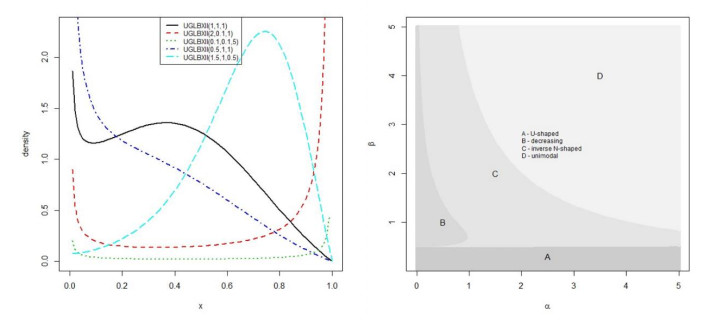









 DownLoad:
DownLoad:

